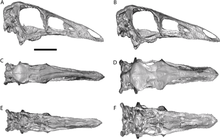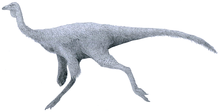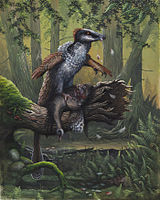Ornithomimus
| Ornithomimus | |
|---|---|

| |
| MountedO. edmontonicusskeleton,Royal Ontario Museum | |
| Scientific classification | |
| Domain: | Eukaryota |
| Kingdom: | Animalia |
| Phylum: | Chordata |
| Clade: | Dinosauria |
| Clade: | Saurischia |
| Clade: | Theropoda |
| Clade: | †Ornithomimosauria |
| Family: | †Ornithomimidae |
| Genus: | †Ornithomimus Marsh,1890 |
| Type species | |
| †Ornithomimus velox Marsh, 1890
| |
| Other species | |
| |
Ornithomimus(/ˌɔːrnɪθəˈmaɪməs,-θoʊ-/;[2]"bird mimic" ) is agenusofornithomimidtheropoddinosaursfrom theCampanianandMaastrichtianages ofLate CretaceousWestern North America.Ornithomimuswas a swift, bipedal dinosaur which fossil evidence indicates was covered infeathersand equipped with a small toothless beak that may indicate anomnivorousdiet. It is usually classified into two species: thetype species,Ornithomimus velox,and a referred species,Ornithomimus edmontonicus.O. veloxwas named in1890byOthniel Charles Marshon the basis of a foot and partial hand from theDenver FormationofColorado.Another seventeen species have been named since then, though almost all of them have been subsequently assigned to new genera or shown to be not directly related toOrnithomimus velox.The best material of species still considered part of the genus has been found inAlberta,representing the speciesO. edmontonicus,known from several skeletons from theHorseshoe Canyon Formation.Additional species and specimens from other formations are sometimes classified asOrnithomimus,such asOrnithomimus samueli(alternately classified in the generaDromiceiomimusorStruthiomimus) from the earlierDinosaur Park Formation.
History of discovery
[edit]First species named
[edit]

The history ofOrnithomimusclassification and the classification of ornithomimids in general has been very complicated. Thetype species,Ornithomimus velox,was first named byO.C. Marshin 1890 and is based onsyntypesYPM 542 and YPM 548 (a partial hindlimb and forelimb, respectively), found byGeorge Lyman Cannonin theDenver FormationofColoradoon June 30,1889.The generic name means "bird mimic", derived from Greek words ὄρνις (ornis), "bird", and μῖμος (mimos), "mimic", in reference to the bird-like foot. Thespecific namemeans "swift" inLatin.[3]Simultaneously, Marsh named two other species:Ornithomimus tenuis(based on specimen USNM 5814) andOrnithomimus grandis.Both consist of fragmentary fossils found byJohn Bell HatcherinMontana,which is today understood astyrannosauroidmaterial. At first, Marsh assumedOrnithomimuswas anornithopod,but this changed when Hatcher found specimen USNM 4736, a partial ornithomimid skeleton, inWyoming.Marsh named itOrnithomimus sedensin1892.On that occasion,Ornithomimus minutuswas also created based on specimen YPM 1049 (ametatarsus),[4]but it has since been recognized as belonging to analvarezsaurid.[5]
A sixth species,Ornithomimus altus,was named in1902byLawrence Lambeand was based on specimen CMN 930 (hindlimbs found in1901inAlberta),[6]but this was renamed to a separate genus in1916:Struthiomimus,byHenry Fairfield Osborn.[7]In1920,Charles Whitney GilmorenamedOrnithomimus affinisforDryosaurus grandis(Lull1911),[8]based on indeterminate material. In1930,Loris RussellrenamedStruthiomimus brevetertius(Parks1926) andStruthiomimus samueli(Parks1928) intoOrnithomimus brevitertiusandOrnithomimus samueli,respectively.[9]The very same year,Oliver Perry HayrenamedAublysodon mirandus(Leidy1868) intoOrnithomimus mirandus,[10]which is today seen as anomen dubium.In1933,William Arthur Parkscreated the speciesOrnithomimus elegans,[11]which is today seen as eitherChirostenotesorElmisaurus.That same year, Gilmore namedOrnithomimus asiaticusfor material found inInner Mongolia.[12]
Also in 1933,Charles Mortram Sternbergnamed the speciesOrnithomimus edmontonicusfor a nearly complete skeleton from the Horseshoe Canyon Formation (specimen CMN 8632).[13]
Reclassification by Dale Russell
[edit]
At first, it had been common practice to name each newly discovered ornithomimid as a species ofOrnithomimus.In the sixties, this tendency was still very strong, as is shown by the fact thatOskar KuhnrenamedMegalosaurus lonzeensis(Dollo1903) fromBelgiumintoOrnithomimus lonzeensis(which is understood today to be anabelisauroidclaw)[14]andDale Russellin1967renamedStruthiomimus currellii(Parks 1933) andStruthiomimus ingens(Parks 1933) intoOrnithomimus currelliiandOrnithomimus ingens,respectively.[15]At the same time, it was usual that workers referred to the entire ornithomimid material as simply "Struthiomimus".[16]To solve this confusion by scientifically testing the separation betweenOrnithomimusandStruthiomimus,Dale Russell in1972published amorphometricstudy. It showed that statistical differences in some proportions could be used to distinguish the two and he concluded thatStruthiomimusandOrnithomimuswere valid genera. In the latter, Russell recognised two species: the type speciesOrnithomimus veloxandOrnithomimus edmontonicus(even though he had trouble reliably distinguishing it fromO. velox). He consideredStruthiomimus currelliito be a younger synonym ofOrnithomimus edmontonicus.However, Russell also interpreted the data as indicating that many specimens could not be referred to eitherOrnithomimusorStruthiomimus.Therefore, he created two new genera. The first one wasArchaeornithomimus.Ornithomimus asiaticusandOrnithomimus affiniswere reassigned to this new genus, becomingArchaeornithomimus asiaticusandArchaeornithomimus affinis.The second one wasDromiceiomimus,meaning "Emumimic ". This comes from the old generic name for the emu:Dromiceius.Russell assigned several formerOrnithomimusspecies named during the 20th century, includingO. brevitertiusandO. ingens,to this new genus asDromiceiomimus brevitertius.He also renamedOrnithomimus samueliinto a secondDromiceiomimusspecies:Dromiceiomimus samueli.[17]
Misassigned toOrnithomimus
[edit]Twotibiaefrom theNavesink FormationofNew Jerseywere namedCoelosaurus antiquus( "antique hollow lizard" ) byJoseph Leidyin1865.The tibiae were first attributed toOrnithomimusin1979byDonald BairdandJohn R. HornerasOrnithomimus antiquus.[18]Normally, this would have madeOrnithomimusajunior synonymofCoelosaurus,but Baird and Horner discovered that the name "Coelosaurus" was preoccupied by adubioustaxon, which was based on a single vertebra. It was originally namedCoelosaurusby an anonymous author now known to beRichard Owenin1854.[19]Baird referred several other specimens from New Jersey andMarylandtoO. antiquus.Beginning in1997,Robert M. SullivanregardedO. veloxandO. edmontonicusas junior synonyms ofO. antiquus.Like Russell, he considered the former two species indistinguishable from each other and noted that they both shared distinctive features withO. antiquus.[20]However,David Weishampel(2004) considered "C."antiquusto be indeterminate among ornithomimosaurs, resulting in it being anomen dubium.[19]An SVP2012abstract agreed with Weishampel by noting thatCoelosaurusdiffers fromGallimimusandOrnithomimusin the features of the tibiae.[21]
In1988,Gregory S. Paulclassified the various species ofArchaeornithomimus,Struthiomimus,Dromiceiomimus,andGallimimusto the genusOrnithomimus.[22]This has found no acceptance among other workers and the name is not presently used by Paul himself.
Present interpretations
[edit]
Even after Russell's study, various researchers have found reasons to lump some or all of these species back intoOrnithomimusin various combinations. In 2004,Peter Makovicky,Yoshitsugu Kobayashi,andPhil Curriestudied Russell's 1972 proportional statistics to re-analyze ornithomimid relationships in light of newly discovered specimens. They concluded that there was no justification to separateDromiceiomimusfromOrnithomimus,sinkingDromiceiomimusas a synonym ofO. edmontonicus.[23]However, they did not include the type speciesO. veloxin this analysis. The same team further supported the synonymy betweenDromiceiomimusandO. edmontonicusin a2006lecture at theSociety of Vertebrate Paleontologyannual meeting.[24]Their opinion has been followed by most later authors.[25]Makovicky's team also consideredDromiceiomimus samuelito be a junior synonym ofO. edmontonicus,though Longrich later suggested it may belong to a distinct, unnamed species from the Dinosaur Park Formation which has yet to be described.[25]Longrich called the speciesOrnithomimus samueliin a faunal list for the Dinosaur Park Formation.[26]
Apart fromO. edmontonicusdating to the early Maastrichtian, two other species are presently considered to be possibly valid and are also from the late Maastrichtian.O. sedenswas named by Marsh in 1892 from partial remains found in theLance FormationofWyominga year after the description ofO. velox.Dale Russell, in his 1972 revision of ornithomimids, could not determine which genus it actually belonged to, though he speculated that it may be intermediate betweenStruthiomimusandDromiceiomimus.In1985,he considered it to be a species ofOrnithomimus.[27]Although it has since been referred to mainly asStruthiomimus sedens(based on complete specimens fromMontanaand some fragments from Alberta andSaskatchewan), these have yet to be described and compared to theO. sedensholotype.[25]
The other is the original type species:O. velox,at first known from very limited remains. Additional specimens referred toO. veloxhave been described from the Denver Formation and from theFerris FormationofWyoming.[28]One specimen attributed toO. velox(MNA P1 1762A) from theKaiparowits FormationofUtahwas described in 1985.[27]Re-evaluation of this specimen by Lindsay Zanno and colleagues in2010,however, cast doubt on its assignment toO. veloxand possibly even toOrnithomimus.[29]This conclusion was supported by a2015re-description ofO. velox,which found that only the holotype specimen was confidently referable to that species. The authors of this study tentatively referred to the Kaiparowits specimen asOrnithomimus sp.,along with all of the specimens from the Dinosaur Park Formation.[1]
Description
[edit]
Like otherornithomimids,species ofOrnithomimusare characterized by feet with three weight-bearing toes, long slender arms, and long necks with birdlike, elongated, toothless, beaked skulls. They werebipedaland superficially resemblant toratites.They would have been swift runners thanks to their very long limbs and hollow bones. They also had large brains and large eyes. The brains of ornithomimids in general were large for non-avialan dinosaurs, but this may not necessarily be a sign of high intelligence. Some paleontologists think that the enlarged portions of the brain were dedicated tokinestheticcoordination.[30]The bones of the hands are remarkably sloth-like in appearance, which ledHenry Fairfield Osbornto suggest that they were used to hook branches during feeding.
Ornithomimusdiffers from other ornithomimids, such asStruthiomimus,in having shorter torsos, long slender forearms, very slender, straight hand and foot claws, and hand bones and fingers of similar lengths.[31]

The twoOrnithomimusspecies today seen as possibly valid differ in size. In 2010,Gregory S. Paulestimated the length ofO. edmontonicusat 3.8 m (12 ft) and its weight at 170 kilograms (370 lb).[32]One of its specimens, CMN 12228, preserves afemurthat is 46.8 centimetres (18.4 in) long.O. velox,thetype speciesofOrnithomimus,is based on material of a smaller animal. Whereas theholotypeofO. edmontonicus,CMN 8632, preserves a secondmetacarpaleighty-four millimetres long, the same element withO. veloxmeasures only fifty-three millimetres.
Feathers and skin
[edit]
Ornithomimus,like many dinosaurs, was long thought to have been scaly. However, beginning in1995,several specimens ofOrnithomimushave been found preserving evidence offeathers.In 1995,2008,and2009,threeOrnithomimus edmontonicusspecimens with evidence of feathers were found (two adults with carbonized traces on the lower arm, indicating the former presence ofpennaceous feathershafts, and a juvenile with impressions of feathers, which were up to five centimetres in length, in the form of hair-like filaments covering the rump, legs, and neck was also discovered). The fact that the feather imprints were found insandstone,previously thought to not be able to support such impressions, raised the possibility of finding similar structures with more careful preparation of future specimens. A study describing the fossils in2012concluded thatO. edmontonicuswas covered in plumaceous feathers at all growth stages and that only adults had pennaceous wing-like structures, suggesting that wings may have evolved for mating displays.[33]In2014,Christian Foth and others argued that the evidence was insufficient to conclude that the forelimb feathers ofOrnithomimuswere necessarily pennaceous, citing the fact that the monofilamentous wing feathers incassowarieswould likely leave similar traces.[34]
A fourth feathered specimen ofOrnithomimus,this time from the lower portion of the Dinosaur Park Formation, was described in October of2015by Aaron van der Reest, Alex Wolfe, and Phil Currie. It was the firstOrnithomimusspecimen to preserve the feathers of its tail. The feathers, though crushed and distorted, bore numerous similarities to those of anostrich,both in structure and distribution. Skin impressions were also preserved in the 2015 specimen, which indicated that, from mid-thigh to the feet, there was bare skin and that a flap of skin connecting the upper thigh to the torso. This latter structure is similar to that found in modern birds, including ostriches, but was positioned higher above the knee inOrnithomimusthan in birds.[35]
Classification
[edit]
In1890,Marsh assignedOrnithomimusto the cladeOrnithomimosauria,a classification that is still very common. Moderncladisticstudies indicate it having a derived position in the ornithomimids. These, however, have only includedO. edmontonicusin their analyses. The relationships betweenO. edmontonicus,O. velox,andO. sedenshave not been published.
The following cladogram is based on Xuet al.,2011:[36]
| Ornithomimidae |
| ||||||||||||||||||||||||||||||
Paleobiology
[edit]
The diet ofOrnithomimusis still highly debated. As theropods, ornithomimids might have been carnivorous, but their body shape would have been suited for a largely omnivorous lifestyle. Suggested food in its diet includes insects, crustaceans, fruit, leaves, branches, eggs, lizards, and small mammals.[30]
Ornithomimushad legs that seem clearly suited for rapid locomotion, with thetibiabeing about 20% longer than thefemur.The large eye sockets suggest a keen visual sense and also suggest the possibility that they werenocturnal.[37]
In a2001study conducted by Bruce Rothschild and other paleontologists, 178 foot bones referred toOrnithomimuswere examined for signs ofstress fracture,but none were found.[38]
See also
[edit]References
[edit]- ^abClaessens, L. & Mark A. Loewen, M.A. (2015). A redescription ofOrnithomimus veloxMarsh, 1890 (Dinosauria, Theropoda).Journal of Vertebrate Paleontology(advance online publication).doi:10.1080/02724634.2015.1034593
- ^"Ornithomimus".LexicoUK English Dictionary.Oxford University Press.Archived fromthe originalon 2020-08-06.
- ^O.C. Marsh, 1890, "Description of new dinosaurian reptiles",The American Journal of Science,series 339:81-86
- ^O.C. Marsh, 1892, "Notice of new reptiles from the Laramie Formation",American Journal of Science43:449-453
- ^Holtz, Thomas R. Jr. (2011)Dinosaurs: The Most Complete, Up-to-Date Encyclopedia for Dinosaur Lovers of All Ages,Winter 2010 Appendix.
- ^Lambe, L., 1902, "New genera and species from the Belly River Series (mid-Cretaceous)",Geological Survey of Canada Contributions to Canadian Palaeontology3(2): 25-81
- ^H.F. Osborn, 1916, "Skeletal adaptations ofOrnitholestes,Struthiomimus,Tyrannosaurus",Bulletin of the American Museum of Natural History35(43): 733-771
- ^Gilmore, C.W., 1920, "Osteology of the carnivorous Dinosauria in the United States National Museum with special reference to the generaAntrodemus(Allosaurus) andCeratosaurus,United States National Museum Bulletin110:l-154
- ^Russell, L.S., 1930, "Upper Cretaceous dinosaur faunas of North America",Proceedings of the American Philosophical Society,69(4): 133-159
- ^Hay, O.P., 1930,Second Bibliography and Catalogue of the Fossil Vertebrata of North America.Carnegie Institution of Washington. 390(II): 1-1074
- ^Parks, W.A., 1933, "New species of dinosaurs and turtles from the Upper Cretaceous formations of Alberta",University of Toronto Studies, Geological Series,34:1-33
- ^Gilmore, C.W., 1933, "On the dinosaurian fauna of the Iren Dabasu Formation",Bulletin of the American Museum of Natural History,67:23-78
- ^Sternberg, C.M., 1933, "A newOrnithomimuswith complete abdominal cuirass ",The Canadian Field-Naturalist47(5): 79-83
- ^Kuhn, O., 1965, "Saurischia (Supplementum 1)". In:Fossilium Catalogus 1. Animalia.109: 1-94
- ^Russell, D.A. and Chamney, T.P., 1967, "Notes on the biostratigraphy of dinosaurian and microfossil faunas in the Edmonton Formation (Cretaceous), Alberta",National Museum of Canada Natural History Papers,35:1-22
- ^Norman, D., 1985,The Illustrated Encyclopedia of Dinosaurs,Crescent Books, New York, p. 48
- ^Russell, D. (1972). "Ostrich dinosaurs from the Late Cretaceous of western Canada."Canadian Journal of Earth Sciences,9:375-402.
- ^Baird D., and Horner, J., 1979, "Cretaceous dinosaurs of North Carolina",Brimleyana2:1-28
- ^abWeishampel, D.B.(2004). "Another Look at the Dinosaurs of the East Coast of North America. En (Colectivo Arqueológico-Paleontológico Salense, Ed.).Archived2012-09-04 at theWayback Machine"Actas de las III Jornadas sobre Dinosaurios y su Entorno.129-168. Salas de los Infantes, Burgos, España.
- ^Sullivan, (1997). "A juvenileOrnithomimus antiquus(Dinosauria: Theropoda: Ornithomimosauria), from the Upper Cretaceous Kirtland Formation (De-na-zin Member), San Juan Basin, New Mexico. "New Mexico Geological Society Guidebook, 48th Field Conference, Mesozoic Geology and Paleontology of the Four Corners Region.249-254.
- ^Brusatte, Choiniere, Benson, Carr and Norell, 2012. Theropod dinosaurs from the Late Cretaceous of Eastern North America: Anatomy, systematics, biogeography and new information from historic specimens. Journal of Vertebrate Paleontology. Program and Abstracts 2012, 70.
- ^Paul, G.S., 1988,Predatory Dinosaurs of the World.Simon & Schuster: New York. 464 pp
- ^Makovicky, Kobayashi and Currie (2004). "Ornithomimosauria." In Weishampel, Dodson and Osmolska (eds.),The Dinosauria Second Edition.University of California Press. 861 pp.
- ^Kobayashi, Makovicky and Currie (2006). "Ornithomimids (Theropoda: Dinosauria) from the Late Cretaceous of Alberta, Canada."Journal of Vertebrate Paleontology,26(3): 86A.
- ^abcLongrich, N. (2008). "A new, large ornithomimid from the Cretaceous Dinosaur Park Formation of Alberta, Canada: Implications for the study of dissociated dinosaur remains."Palaeontology,51(4): 983-997.
- ^Longrich, N. R. (2014). "The horned dinosaursPentaceratopsandKosmoceratopsfrom the upper Campanian of Alberta and implications for dinosaur biogeography ".Cretaceous Research,51:292.doi:10.1016/j.cretres.2014.06.011
- ^abDeCourten and Russell, D. (1985). "A specimen ofOrnithomimus velox(Theropoda, Ornithomimidae) from the terminal Cretaceous Kaiparowits Formation of southern Utah. "Journal of Paleontology,59(5): 1091-1099.
- ^Lillegraven and Eberle (1999). "Vertebrate faunal changes through Lancian and Puercan time in southern Wyoming."Journal of Paleontology,73(4): 691-710.
- ^Zanno, L.E., Weirsma, J.P., Loewen, M.A., Sampson, S.D. and Getty, M.A. (2010).A preliminary report on the theropod dinosaur fauna of the late Campanian Kaiparowits Formation, Grand Staircase-Escalante National Monument, Utah.[permanent dead link]"Learning from the Land Symposium: Geology and Paleontology.Washington, DC: Bureau of Land Management.
- ^ab"Dromiceiomimus." In: Dodson, Peter & Britt, Brooks & Carpenter, Kenneth & Forster, Catherine A. & Gillette, David D. & Norell, Mark A. & Olshevsky, George & Parrish, J. Michael & Weishampel, David B.The Age of Dinosaurs.Publications International, LTD. p. 140.ISBN0-7853-0443-6.
- ^Makovicky, P.J., Kobayashi, Y., and Currie, P.J. (2004). "Ornithomimosauria." In Weishampel, D.B., Dodson, P., & Osmólska, H. (eds.),The Dinosauria (second edition).University of California Press, Berkeley: 137-150.
- ^Paul, Gregory S. (2010).The Princeton Field Guide to Dinosaurs.Princeton, NJ: Princeton University Press. p.117.ISBN978-0-691-13720-9.
- ^Zelenitsky, D. K.; Therrien, F.; Erickson, G. M.; Debuhr, C. L.; Kobayashi, Y.; Eberth, D. A.; Hadfield, F. (2012). "Feathered Non-Avian Dinosaurs from North America Provide Insight into Wing Origins".Science.338(6106): 510–514.Bibcode:2012Sci...338..510Z.doi:10.1126/science.1225376.PMID23112330.S2CID2057698.
- ^Christian Foth; Helmut Tischlinger; Oliver W. M. Rauhut (2014). "New specimen ofArchaeopteryxprovides insights into the evolution of pennaceous feathers ".Nature.511(7507): 79–82.Bibcode:2014Natur.511...79F.doi:10.1038/nature13467.PMID24990749.S2CID4464659.
- ^Van Der Reest, Aaron J.; Wolfe, Alexander P.; Currie, Philip J. (2016). "A densely feathered ornithomimid (Dinosauria: Theropoda) from the Upper Cretaceous Dinosaur Park Formation, Alberta, Canada".Cretaceous Research.58:108–117.doi:10.1016/j.cretres.2015.10.004.
- ^Xu, L.; Kobayashi, Y.; Lü, J.; Lee, Y. N.; Liu, Y.; Tanaka, K.; Zhang, X.; Jia, S.; Zhang, J. (2011). "A new ornithomimid dinosaur with North American affinities from the Late Cretaceous Qiupa Formation in Henan Province of China".Cretaceous Research.32(2): 213.doi:10.1016/j.cretres.2010.12.004.
- ^Palmer, D., ed. (1999).The Marshall Illustrated Encyclopedia of Dinosaurs and Prehistoric Animals.London: Marshall Editions. p. 109.ISBN978-1-84028-152-1.
- ^Rothschild, B., Tanke, D. H., and Ford, T. L., 2001, Theropod stress fractures and tendon avulsions as a clue to activity: In: Mesozoic Vertebrate Life, edited by Tanke, D. H., and Carpenter, K., Indiana University Press, p. 331-336.
Further reading
[edit]- Claessens, L., Loewen, M. and Lavender, Z. 2011. A reevaluation of the genusOrnithomimusbased on new preparation of the holotype ofO. veloxand new fossil discoveries. Journal of Vertebrate Paleontology, SVP Program and Abstracts Book, 2011, pp. 90.
- Reisdorf, A.G., and Wuttke, M. 2012. Re-evaluating Moodie's Opisthotonic-Posture Hypothesis in fossil vertebrates. Part I: Reptiles - The taphonomy of the bipedal dinosaursCompsognathus longipesandJuravenator starkifrom the Solnhofen Archipelago (Jurassic, Germany). Palaeobiodiversity and Palaeoenvironments,doi:10.1007/s12549-011-0068-y
- Ornithomimids
- Feathered dinosaurs
- Maastrichtian life
- Campanian genus first appearances
- Maastrichtian genus extinctions
- Late Cretaceous dinosaurs of North America
- Hell Creek fauna
- Horseshoe Canyon fauna
- Paleontology in Colorado
- Paleontology in Alberta
- Laramie Formation
- Paleontology in Montana
- Paleontology in South Dakota
- Paleontology in North Dakota
- Fossil taxa described in 1890
- Taxa named by Othniel Charles Marsh
- Multispecific non-avian dinosaur genera















